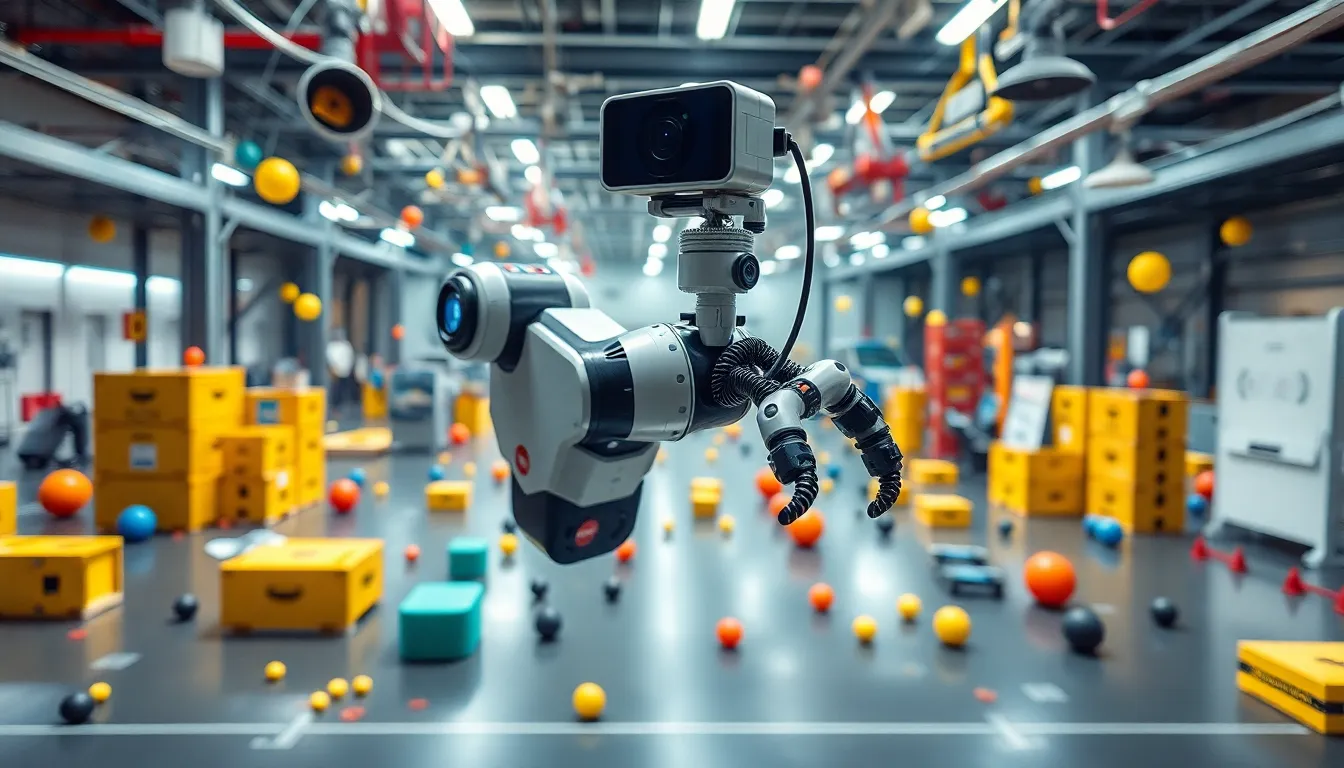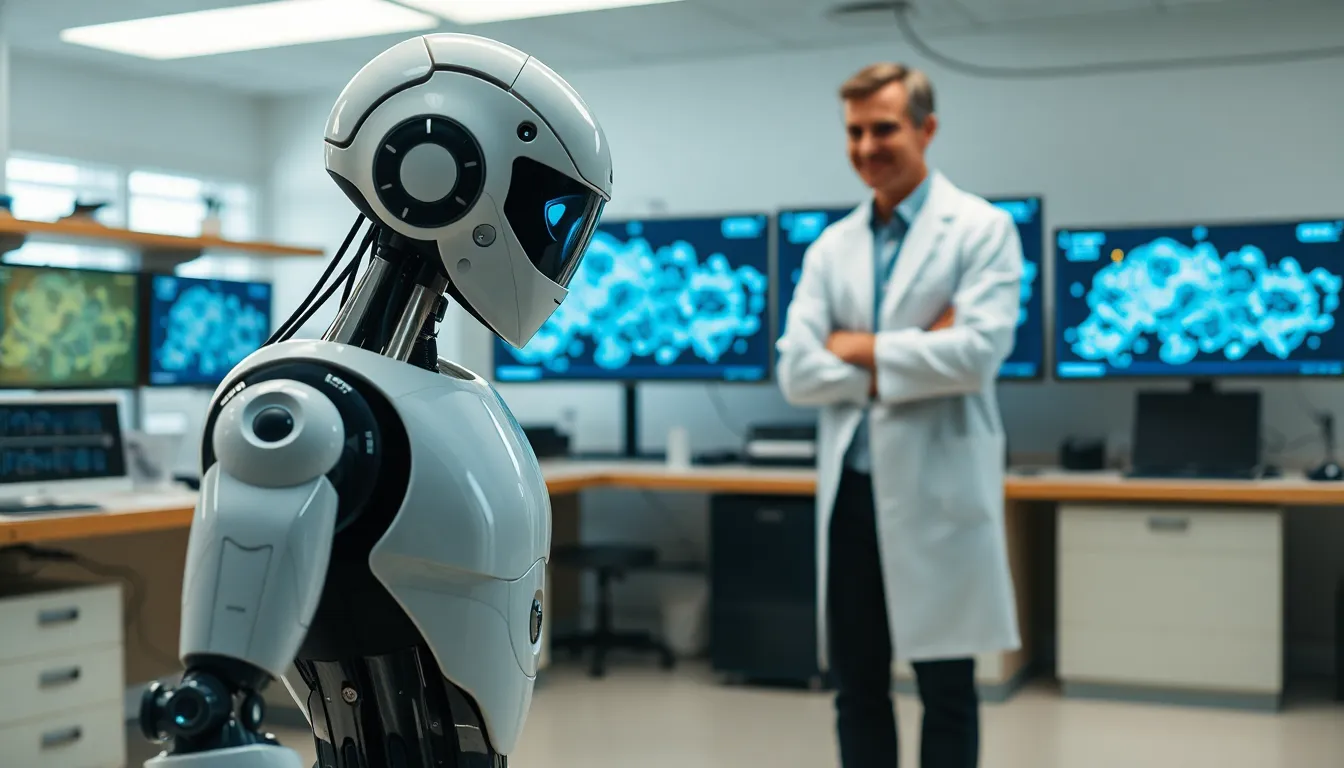In a world where robots are no longer just the stuff of sci-fi movies, neural networks are turning them into intelligent companions. Imagine a robot that can learn, adapt, and maybe even crack a joke or two—now that’s a game changer! With the power of neural networks, these machines are stepping up their game, transforming from clunky assistants to smart, decision-making entities.
Table of Contents
ToggleOverview of Neural Networks for Robots
Neural networks serve as the backbone of modern robotics, facilitating advanced functionalities within machines. They enable robots to process complex data, identify patterns, and make informed decisions. These networks mimic human brain processes, allowing robots to learn from experiences and adapt to their environments.
Transforming raw data into actionable insights occurs through several layers of interconnected nodes in neural networks. Input layers receive data from sensors, while hidden layers process the information, and output layers deliver responses or actions. This architecture allows robots to achieve tasks such as object recognition, movement planning, and natural language processing.
Training models with large datasets strengthens the efficiency of neural networks. Supervised learning involves labeled data, which enhances robots’ capabilities in specific tasks. Unsupervised learning lets robots identify patterns without guidance, promoting autonomous learning. Reinforcement learning encourages robots to optimize their actions based on feedback, improving their performance over time.
Research indicates that neural networks can enhance robots in various applications. In healthcare, for instance, robots with neural networks assist with patient monitoring and surgical precision. In manufacturing, they streamline production processes, ensuring quality control and efficiency. Autonomous vehicles leverage neural networks for navigation, perceiving their surroundings accurately.
Understanding the architecture and operation of neural networks proves essential for developers. Mastering these concepts enables engineers to design intelligent robotics systems capable of performing complicated tasks. The integration of neural networks with robotics heralds a new era in automation, pushing the boundaries of what machines can achieve.
Types of Neural Networks Used in Robotics

Neural networks greatly enhance robotic capabilities through various architectures. Two primary types include convolutional neural networks and recurrent neural networks.
Convolutional Neural Networks
Convolutional neural networks (CNNs) excel in processing visual data. They analyze images to identify objects, enabling robots to navigate environments effectively. CNNs leverage convolutional layers and pooling layers to detect features like edges and textures. Training on large image datasets allows these networks to outperform traditional algorithms in tasks such as face recognition and scene analysis. Many robotics applications, particularly in autonomous vehicles, utilize CNNs for real-time image processing. CNNs therefore play a crucial role in enabling robots to understand and interpret their surroundings.
Recurrent Neural Networks
Recurrent neural networks (RNNs) specialize in sequential data processing. They maintain memory of previous inputs, which assists robots in tasks involving time-series data or natural language processing. Utilizing feedback connections, RNNs analyze and predict patterns over time, making them ideal for applications like speech recognition and dialogue systems. These networks adapt by learning from new data, enhancing their performance with ongoing interaction. RNNs contribute significantly to making robots more efficient in understanding human commands and responding appropriately, resulting in smoother human-robot interactions.
Applications of Neural Networks in Robotics
Neural networks significantly influence various applications in robotics, enhancing functionality and performance across multiple sectors.
Autonomous Navigation
Autonomous navigation utilizes neural networks to help robots traverse complex environments. By processing sensory data from cameras and LiDAR, these networks enable robots to create detailed maps and determine optimal paths. Real-time decision-making improves as machines assess obstacles and variables with incredible accuracy. Robots equipped with this technology efficiently navigate warehouses, factories, and urban settings, demonstrating adaptability in dynamic situations. Notably, autonomous vehicles rely heavily on neural networks to interpret surroundings, ensuring safe travel. These systems continue to evolve, promising even greater precision in future applications.
Object Recognition
Object recognition remains a crucial application for neural networks in robotics. The use of convolutional neural networks (CNNs) empowers robots to analyze and identify objects in their environment effectively. Training with extensive datasets increases accuracy in distinguishing items, essential for tasks like sorting packages or identifying components on an assembly line. Recognizing patterns in visual data allows robots to take appropriate actions based on their analysis. Innovations in this area lead to improved safety and efficiency in industries where precision is key, such as manufacturing and logistics.
Human-Robot Interaction
Human-robot interaction benefits greatly from neural networks, enhancing engagement and communication. Through natural language processing powered by recurrent neural networks (RNNs), robots interpret spoken commands and respond appropriately. This capability fosters more intuitive interactions between humans and machines. Additionally, facial recognition and emotional analytics enable robots to understand human emotions, allowing for a more empathetic response. The advancements in this field increase trust and collaboration, making robots more integrated into everyday life and workspaces. Enhanced interaction transforms the user experience and promotes broader acceptance of robotic technologies.
Challenges in Implementing Neural Networks for Robots
Implementing neural networks in robotics presents several challenges. These hurdles can impact performance and efficiency in robotic systems.
Data Requirements
Data requirements stand as a significant obstacle. Large, diverse datasets are crucial for training neural networks effectively. Gathering enough data can be resource-intensive. Researchers often face difficulties in obtaining datasets that accurately represent real-world scenarios. Insufficient or biased datasets can lead to models that don’t generalize well. Ensuring a balance of data types enhances training quality. Robust data collection methods contribute to model accuracy and reliability.
Computational Power
Computational power serves as another critical challenge. Training complex neural networks demands extensive processing capabilities. High-performance hardware, such as GPUs, often incurs substantial costs. Limited computational resources can slow down the training process. Consequently, this restriction may hinder experimentation and innovation in robotic applications. Optimizing algorithms can alleviate some computational strain. Efficient use of resources helps maintain feasible training times while improving model performance.
Future Trends in Neural Networks for Robots
Continued advancements in neural networks are shaping the future of robotics. Emerging trends suggest increased integration of deep learning techniques that enhance machine learning capabilities. These improvements lead to more adaptive robots equipped to handle complex environments.
Robots equipped with advanced neural networks demonstrate enhanced decision-making processes. For instance, advancements in unsupervised learning allow robots to interpret sensor data independently, reducing reliance on pre-labeled datasets. Greater autonomy in learning improves both efficiency and performance in various applications.
Incorporating edge computing stands out among future trends. Edge devices process data closer to the source, minimizing latency and enhancing real-time decision-making. This shift is significant for applications like autonomous vehicles, where split-second decisions are crucial.
The role of transfer learning is also becoming more prominent. By applying knowledge gained from one task to similar tasks, robots can learn quicker and require less data for training. This ability accelerates deployment in diverse fields, from manufacturing to healthcare.
Natural language understanding in robots continues to expand. Future neural networks will better interpret and respond to human commands, fostering improved human-robot collaboration. Enhanced emotional analytics additionally helps robots gauge human reactions, making interactions feel more intuitive.
With the push toward more sustainable robotics, energy-efficient neural networks emerge as a necessity. Developing algorithms that consume less power while delivering high performance addresses environmental concerns. Focus on sustainability doesn’t only align with global priorities; it paves the way for practical robotic solutions.
Lastly, the influence of human-like cognitive functions in neural networks will likely redefine next-generation robots. By mimicking aspects of human reasoning and problem-solving, these systems could tackle challenges previously deemed insurmountable, solidifying the role of robotics in daily life.
Neural networks are revolutionizing the capabilities of robots, enabling them to perform tasks that once seemed impossible. As robots evolve into intelligent companions, their ability to learn and adapt through advanced neural architectures is reshaping industries and everyday life.
The integration of deep learning techniques and enhanced decision-making processes will continue to drive innovation. With emerging trends like edge computing and transfer learning, robots are set to become more efficient and effective in various applications.
As the field progresses, the focus on sustainable and energy-efficient designs ensures that the future of robotics aligns with environmental considerations. The journey of neural networks in robotics promises not just smarter machines but also a deeper collaboration between humans and robots, paving the way for a more integrated future.





